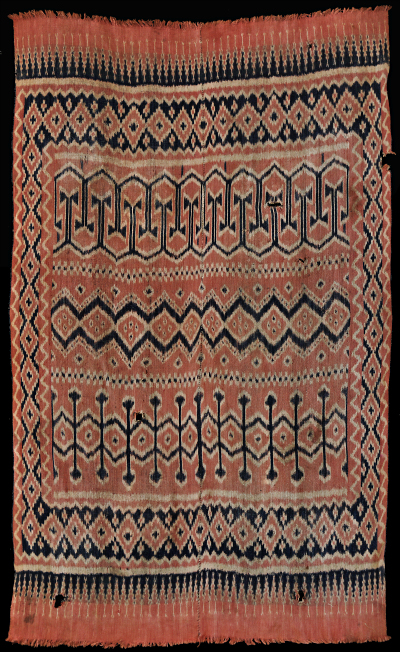| |
 
 | | | |
225 Sulawesi, Toraja
Ceremonial sarong or shroud  
| | Locale: | Probably made in Rongkong for Karataon Toraja who live in the mountains near the western coast. | | Period: | Early 20th c. | | Yarn: | Cotton, hand-spun, coarse, double-ply | | Technique: | Warp ikat | | Panels: | 2 | | Size: | 90.5 x 154 cm (2' 11" x 5' 0") LW: 1.70 | | Weight: | 380 g (13.4 oz), 273 g/m2 (0.89 oz/ft2) | | Design: | Cloth with unusual patterning, more similar to that of the much longer pori lonjong than of most sekomandi and pori situtu. Midfield consisting of three rows with different angular designs in black and ecru on morinda red background, considered patola-inspired by Bühler (see below). Border with larger and smaller lozenges on all four sides, end borders with what are probably very fine tumpal motifs. | | Comment: | Certainly a type of ceremonial cloth, but intended usage is uncertain. Given the dimensions (much shorter than pori lonjong and unlike seko mandi and pori sitututu oblong rather than almost square) it is most likely either a ceremonial sarong, sora langi, or a popori To Noling. Both sora langi and popori To Noling are rare. Few, if any, have been made since the end of the 19th C. Three small holes, and minor damage to one selvedge, otherwise in excellent condition for its age. Cloth has a soft, well worn feel. � | | Background: | Chapters on Sulawesi and Toraja. | | Compare: | 064 065 066 067 | | Sources: | Very similar to Rongkong cloth shown in Bühler and Fischer, The Patola of Gujarat, Vol. II, Fig. 243. Patterns also similar to those on a 1900-1920 Karataon pori lonjong possibly made in Rongkong in the Holy Cross Collection, Nr. 2010.09.05. Somewhat similar to Dallas Museum of Art, Nr. 1990.203. Another somewhat similar but new piece, created by a Threads of Life weaver and possibly inspired by Karataon Toraja paporitonoling, was acquired by Holy Cross College. | | |

©Peter ten Hoopen, 2025
All rights reserved.
|
|


